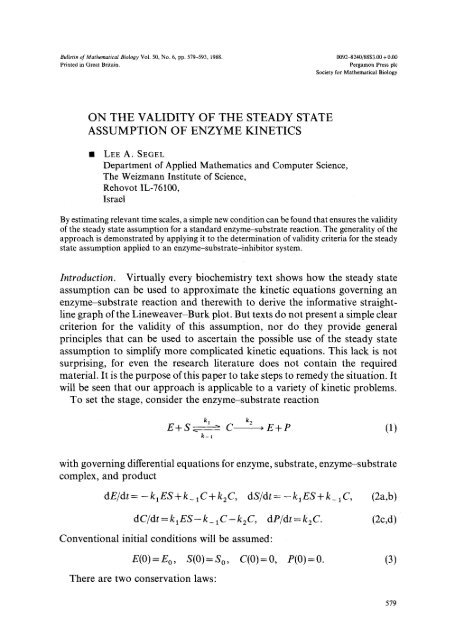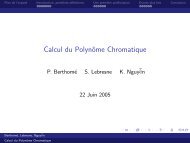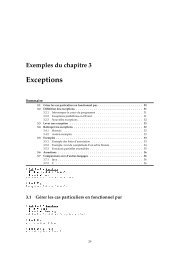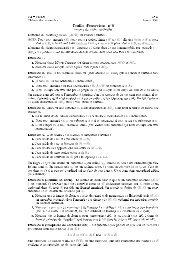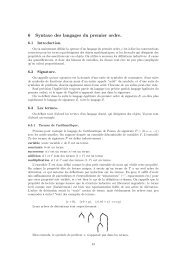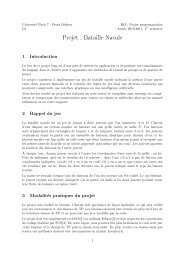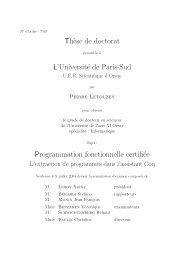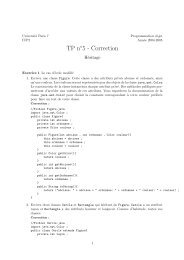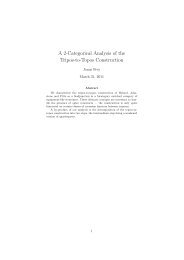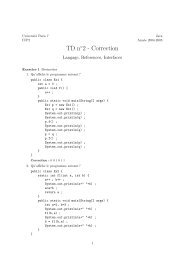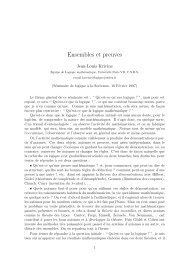On the validity of the steady state assumption of enzyme kinetics
On the validity of the steady state assumption of enzyme kinetics
On the validity of the steady state assumption of enzyme kinetics
Create successful ePaper yourself
Turn your PDF publications into a flip-book with our unique Google optimized e-Paper software.
Bulletin <strong>of</strong> Ma<strong>the</strong>matical Biolooy Vol. 50, No. 6, pp. 579-593, 1988.<br />
Printed in Great Britain.<br />
ON THE VALIDITY OF THE STEADY STATE<br />
ASSUMPTION OF ENZYME KINETICS<br />
LEE A. SEGEL<br />
Department <strong>of</strong> Applied Ma<strong>the</strong>matics and Computer Science,<br />
The Weizmann Institute <strong>of</strong> Science,<br />
Rehovot IL-76100,<br />
Israel<br />
0092-8240/8853.00 + 0.00<br />
Pergamon Press plc<br />
Society for Ma<strong>the</strong>matical Biology<br />
By estimating relevant time scales, a simple new condition can be found that ensures <strong>the</strong> <strong>validity</strong><br />
<strong>of</strong> <strong>the</strong> <strong>steady</strong> <strong>state</strong> <strong>assumption</strong> for a standard <strong>enzyme</strong>-substrate reaction. The generality <strong>of</strong> <strong>the</strong><br />
approach is demonstrated by applying it to <strong>the</strong> determination <strong>of</strong> <strong>validity</strong> criteria for <strong>the</strong> <strong>steady</strong><br />
<strong>state</strong> <strong>assumption</strong> applied to an <strong>enzyme</strong>-substrate-inhibitor system,<br />
Introduction. Virtually every biochemistry text shows how <strong>the</strong> <strong>steady</strong> <strong>state</strong><br />
<strong>assumption</strong> can be used to approximate <strong>the</strong> kinetic equations governing an<br />
<strong>enzyme</strong>-substrate reaction and <strong>the</strong>rewith to derive <strong>the</strong> informative straight-<br />
line graph <strong>of</strong> <strong>the</strong> Lineweaver-Burk plot. But texts do not present a simple clear<br />
criterion for <strong>the</strong> <strong>validity</strong> <strong>of</strong> this <strong>assumption</strong>, nor do <strong>the</strong>y provide general<br />
principles that can be used to ascertain <strong>the</strong> possible use <strong>of</strong> <strong>the</strong> <strong>steady</strong> <strong>state</strong><br />
<strong>assumption</strong> to simplify more complicated kinetic equations. This lack is not<br />
surprising, for even <strong>the</strong> research literature does not contain <strong>the</strong> required<br />
material. It is <strong>the</strong> purpose <strong>of</strong> this paper to take steps to remedy <strong>the</strong> situation. It<br />
will be seen that our approach is applicable to a variety <strong>of</strong> kinetic problems.<br />
To set <strong>the</strong> stage, consider <strong>the</strong> <strong>enzyme</strong>-substrate reaction<br />
k 1 k 2<br />
E+S. -----~ C ~ E+P (1)<br />
k-I<br />
with governing differential equations for <strong>enzyme</strong>, substrate, <strong>enzyme</strong>-substrate<br />
complex, and product<br />
dE/dt=--klES+k_lC+k2C, dS/dt=-kiES+k ~C, (2a,b)<br />
dC/dt = k~ES- k_ ~C- kzC, dP/dt = k2C. (2c,d)<br />
Conventional initial conditions will be assumed:<br />
E(0)=Eo, S(0)=S o, C(0)=0, P(0)=0. (3)<br />
There are two conservation laws:<br />
579
580 LEE A. SEGEL<br />
E(t) + C(t) = Eo, S(t) + C(t) + P(t) = S o . (4a,b)<br />
Employment <strong>of</strong> (4a) to eliminate E yields <strong>the</strong> basic ma<strong>the</strong>matical problem<br />
dS/dt = - kl (Eo - C)S + k_ ~ C, (5a)<br />
dC/dt= kx(E o - C)S- (k_ , + k2)C, (5b)<br />
S(O)=S o, C(O)=O. (5c,d)<br />
According to <strong>the</strong> <strong>steady</strong> <strong>state</strong> approximation, after an initial brief transient<br />
period it is <strong>of</strong>ten possible to neglect <strong>the</strong> dC/dt term in (5b). With its left side<br />
replaced by zero, (5b) becomes an algebraic equation that is easily solved to<br />
yield<br />
C=EoS/(Km+ S), Km ==-(k_~ +k2)/k ~. (6a,b)<br />
Upon substituting (6a) into (5a) one obtains<br />
dS/dt = - k2EoS/(K . + S). (7)<br />
It is also conventionally assumed that a negligible amount <strong>of</strong> substrate is<br />
consumed during <strong>the</strong> fast transition period, so that (7) can be solved subject to<br />
<strong>the</strong> initial condition<br />
In addition, substitution <strong>of</strong> (6a) into (2d) shows that<br />
s(o) = So. (8)<br />
VmaxS V dP Vma x = k2E o. (9a,b,c)<br />
V-Km+S where =dt'<br />
It is frequently <strong>the</strong> case in <strong>the</strong> laboratory that <strong>the</strong> initial value (just after <strong>the</strong><br />
brief transient) <strong>of</strong> <strong>the</strong> derivative dS/dt can be estimated by observing a linear<br />
decrease in substrate over a "relatively short" time period, so that S does not<br />
decrease appreciably from S O . Then (9) can be applied to <strong>the</strong> initial reaction<br />
velocity V 0 :<br />
1<br />
V~ K,. + S O or Vo -- Vmax 1 + . (lOa,b)<br />
Equation (10b) in principle permits determination <strong>of</strong> Vma ~ and K,, from a<br />
Lineweaver-Burk) plot <strong>of</strong> 1/V o as a function <strong>of</strong> 1/S o . [It is outside <strong>the</strong> scope <strong>of</strong><br />
this paper to consider <strong>the</strong> most efficient way to plot <strong>the</strong> data. Fersht (1985) is an<br />
excellent general reference for enzymology.]<br />
This recapitulation <strong>of</strong> standard material allows us to pose several questions,<br />
which turn out to be closely related. (a) How can we estimate <strong>the</strong> duration <strong>of</strong>
STEADY STATE ASSUMPTION OF ENZYME KINETICS 581<br />
<strong>the</strong> fast transition period? (b) How can we estimate how long it takes for <strong>the</strong><br />
substrate concentration to decrease significantly? (c) For what ranges <strong>of</strong><br />
parameters is <strong>the</strong> <strong>steady</strong> <strong>state</strong> <strong>assumption</strong> valid? (d) If <strong>the</strong> <strong>steady</strong> <strong>state</strong><br />
<strong>assumption</strong> is regarded as a first approximation, how can a second<br />
approximation be found?<br />
A Didactic Example. It is instructive at this point to consider a simple exactly<br />
solvable example. Consider <strong>the</strong> kinetic scheme<br />
with <strong>the</strong> corresponding equations<br />
k 1 k 2<br />
A ~B ~C<br />
dA/dt=-kiA, A(0)=Ao;<br />
dB/dt=klA-k2B, B(0)=B o.<br />
C(t)=T-A(t)-B(t); T=Ao+Bo+Co, Co=C(0 ).<br />
The elementary <strong>the</strong>ory <strong>of</strong> differential equations yields <strong>the</strong> solutions<br />
and, if k 1 ~ k2,<br />
B(t) = B o exp(-- k2t )<br />
A(t)=Ao exp(-klt),<br />
kiAo<br />
Now C(t) can be determined from (14a).<br />
Consider <strong>the</strong> situation wherein<br />
- - [exp(-- k2t ) - exp(-- k 1 t)].<br />
k 2 - k 1<br />
(11)<br />
(12a,b)<br />
(13a,b)<br />
(14a,b)<br />
(15)<br />
(16)<br />
k 2 ~ kl, i.e. k i 1 ~ k? 1. (17a,b)<br />
For a relatively short time <strong>of</strong> order k~-l, exp(_klt) ~ 1 so that (16) can be<br />
approximated by<br />
B(t),,~ B o exp(-- k2t )- (klAo/k2) [exp(- k2t )- 1]. (18)<br />
According to (18), B(t) rapidly approaches <strong>the</strong> value klAo/k2. For longer times<br />
exp(- k2t ) is negligible. Now <strong>the</strong> following approximation <strong>of</strong> (16) describes <strong>the</strong><br />
relatively slow decay <strong>of</strong> B(t) from its "initial" (after <strong>the</strong> fast transient) value<br />
kiAo/k 2 "..<br />
B( t ) ~ (ki Ao/k2)exp(- kit ). (19)<br />
The key observation is that from (15) and (19) it follows that
582 LEE A. SEGEL<br />
B(t),~ (kl/k2)A(t), after <strong>the</strong> initial transient. (20)<br />
Equation (20) would be obtained from (13a) if we assumed that dB/dt could be<br />
set equal to zero. But nei<strong>the</strong>r B(t) nor A(t) are in a <strong>steady</strong> <strong>state</strong>: <strong>the</strong>y vary in time<br />
according to (15) and (16). Evidently dB/dt can be regarded as "very small"<br />
(after <strong>the</strong> fast transient), yielding what is <strong>of</strong>ten called a quasi-<strong>steady</strong> <strong>state</strong><br />
relation (20). Such a relation holds under <strong>the</strong> conditions (17) because <strong>the</strong> time<br />
scale k 21 for a change in B(t) is so short compared to <strong>the</strong> corresponding time<br />
scale k 11 for <strong>the</strong> change in A(t). With this relation between time scales, B(t) can<br />
always completely "keep up" with--i.e, remain in a "<strong>steady</strong>-<strong>state</strong>" with respect<br />
to--<strong>the</strong> changing concentration A(t).<br />
The principles just enunciated are quite general. The counterpart <strong>of</strong> <strong>the</strong><br />
quasi-<strong>steady</strong> <strong>state</strong> relation (20) between B(t) and A(t) is relation (6a) between<br />
<strong>the</strong> complex C(t) and <strong>the</strong> substrate S(t). Analogously to (17) we expect <strong>the</strong><br />
(quasi) <strong>steady</strong>-<strong>state</strong> relation to be valid only if <strong>the</strong> time-scale t c that<br />
characterizes changes in complex concentration is small compared to <strong>the</strong> time-<br />
scale t s for substrate changes. The question is, how can we obtain estimates <strong>of</strong> t c<br />
and ts? We now turn to this matter.<br />
Estimatin9 Time Scales. We begin with question (a). During <strong>the</strong> brief<br />
transient period <strong>the</strong> substrate concentration is not expected to change<br />
appreciably. Particularly because we want an estimate <strong>of</strong> <strong>the</strong> duration <strong>of</strong> this<br />
period (milliseconds, seconds, minutes?) we can make <strong>the</strong> approximation<br />
S= S o in (5b). This transforms (5b) into a linear equation, with <strong>the</strong> solution<br />
C(t)=C[1-exp(-2t)], C-EoSo/(Km+So) , 2=_kl(So+Km). (21a,b,c)<br />
Thus <strong>the</strong> complex (fast) time scale is given by t c = 2-1, i.e.<br />
tc = [kl(So + Km)] - 1<br />
Turning to question (b), we wish to estimate how long it will take for a<br />
significant change to occur in <strong>the</strong> substrate concentration. We denote this<br />
substrate (slow) time scale by t s. We employ <strong>the</strong> characterization (Segel, 1984,<br />
p. 56)<br />
(22)<br />
total change in S after fast transient<br />
ts ~ max]dS/dt] after fast transient (23)<br />
The time scale t s is an estimate <strong>of</strong> how long it takes for an appreciable change in<br />
<strong>the</strong> substrate concentration S. Formula (23) makes compensating over-<br />
estimates in providing <strong>the</strong> time for <strong>the</strong> total change in S, assuming that<br />
substrate depletion is at a maximal rate.
STEADY STATE ASSUMPTION OF ENZYME KINETICS 583<br />
The numerator <strong>of</strong> (23) is approximately S o . Assuming <strong>the</strong> <strong>validity</strong> <strong>of</strong> <strong>the</strong><br />
<strong>steady</strong> <strong>state</strong> <strong>assumption</strong>, we observe that <strong>the</strong> denominator is given by (7) with<br />
S = S O . Thus t s ~ So/[k2EoSo/(K m -t- So) ], i.e.<br />
t s = (K m + So)/k2E o . (24)<br />
As a numerical example we can employ data for <strong>the</strong> hydrolysis <strong>of</strong><br />
benzoyl-L-arginine ethyl ester by trypsin where [as cited by Wong (1965)]<br />
k1=4 -lsec -1, k_l=25sec -1, k2=15sec -1 so that if So=KIn,<br />
E o = 10 -3 S o <strong>the</strong>n tc= 1/80 sec, ts= 133 sec.<br />
Criteria for <strong>the</strong> Validity <strong>of</strong> <strong>the</strong> Steady State Approximation. We are now ready<br />
to obtain some simple necessary criteria for <strong>the</strong> <strong>validity</strong> <strong>of</strong> <strong>the</strong> <strong>steady</strong> <strong>state</strong><br />
<strong>assumption</strong>. <strong>On</strong>e such criterion is that <strong>the</strong> "brief transient" is indeed short<br />
compared to <strong>the</strong> time during which <strong>the</strong> substrate changes appreciably. This<br />
criterion is t c ~ t s or, from (22) and (24)<br />
Km+S~o4~ 1 + 1 +~s .<br />
In an alternative interpretation, t c ~ t s is <strong>the</strong> analog <strong>of</strong> condition (17b) for <strong>the</strong><br />
approximation (20).<br />
A second criterion concerns <strong>the</strong> "initial" condition (8). For this condition to<br />
be approximately valid <strong>the</strong>re must be only a negligible decrease in substrate<br />
concentration during <strong>the</strong> duration t c <strong>of</strong> <strong>the</strong> brief transient. This decrease, which<br />
we denote by AS, is certainly less than <strong>the</strong> product <strong>of</strong> <strong>the</strong> time duration t c and<br />
<strong>the</strong> initial (maximal) rate <strong>of</strong> substrate consumption. '"Initial" in <strong>the</strong> previous<br />
sentence refers to <strong>the</strong> very beginning <strong>of</strong> <strong>the</strong> experiment, so that <strong>the</strong> desired rate<br />
is obtained by setting t--0 in (5a). This yields<br />
A oS I dS E o (26)<br />
= S Odt max "tc- Km+S~o"<br />
The requirement that lAX/Sol be small compared to unity is thus expressed by<br />
Eo<br />
e ~ 1, where e - - - (27)<br />
Km+S o"<br />
If (27) holds <strong>the</strong>n (25) holds. Thus we propose e ~ 1 as <strong>the</strong> desired simple criterion<br />
for <strong>the</strong> <strong>validity</strong> <strong>of</strong> <strong>the</strong> <strong>steady</strong> <strong>state</strong> <strong>assumption</strong>.<br />
To check (27) let us examine <strong>the</strong> maximum velocity Vma x ~ IdP/dtlmax <strong>of</strong> <strong>the</strong><br />
reaction. From (2d) and (21b) we see that<br />
Vm(Calculated) c(calculated)<br />
ax __ --max (28)<br />
VCm QssA C
584 LEE A, SEGEL<br />
Equations (A1.1-4) <strong>of</strong> <strong>the</strong> appendix show that <strong>the</strong> dimensionless variable C/C<br />
depends only on <strong>the</strong> dimensionless parameters e, a = So/K m and x = k_ 1/k2. It<br />
is most important to examine <strong>the</strong> error when S O ~ K m, so that we take tr = 1 and<br />
calculate <strong>the</strong> ratio (28) for a range <strong>of</strong> values <strong>of</strong> x and for e=0.1 and 0.01.<br />
Figure 1 shows that <strong>the</strong> condition<br />
~
S<br />
STEADY STATE ASSUMPTION OF ENZYME KINETICS 585<br />
I I I I I I I I I<br />
I I I I I r I I I<br />
0 0 I 2<br />
T<br />
Figure 2. Comparison between <strong>the</strong> QSSA (dashed curves) and numerical<br />
integration (solid curves) when S o = E o but ~- Eo/(S o + K,) = 0.1 (x = 10, a = 1/9).<br />
The QSSA gives a good approximation even though <strong>the</strong> "small" parameter Eo/S o<br />
has <strong>the</strong> value unity. [All simulations were carried out using <strong>the</strong> BIOGRAPH<br />
package written by G. M. Odell. See Odell and Segel (1987).]<br />
use <strong>of</strong> "correct" dimensionless variables. See Appendix for an outline <strong>of</strong> how to<br />
proceed.<br />
Effects <strong>of</strong> Reversibility in Product Formation. Let us now take into account <strong>the</strong><br />
reversibility <strong>of</strong> product formation by decomposition <strong>of</strong> complex, so that (1) is<br />
modified to<br />
k~ k 2<br />
E+S~ -----~ C_ " E+P.<br />
k-I k-2<br />
Then <strong>the</strong> complex and product equations become<br />
dC/dt=k~(Eo-C)S-(k_x +k2)C+k_E(Eo-C)P, (29a)<br />
dP/dt = k2C- k_ 2(Eo -- C)P. (29b)<br />
In <strong>the</strong> brief transient layer, our previous estimates <strong>of</strong> t c and C will be accurate<br />
if <strong>the</strong> additional term k_ 2 (Eo - C)P is negligible, i.e. if<br />
Ik-2(E0 - C)P I ~ k2C. (30)<br />
To clarify <strong>the</strong> meaning <strong>of</strong> (30) we employ (2d) to estimate <strong>the</strong> product<br />
concentration Pi at <strong>the</strong> end <strong>of</strong> <strong>the</strong> fast time interval. We take <strong>the</strong> product <strong>of</strong> <strong>the</strong>
586 LEE A. SEGEL<br />
rate constant k2, <strong>the</strong> duration <strong>of</strong> <strong>the</strong> interval tc, and an average complex<br />
concentration C/2 yielding<br />
Pi~k2(ff/2)tc . (31)<br />
Employing P,,~ Pi and substituting for t c and C from (22) and (21b) we find that<br />
(30) holds if<br />
k 2 E
STEADY STATE ASSUMPTION OF ENZYME KINETICS 587<br />
Estimate (31) for <strong>the</strong> product concentration can be used to obtain in ano<strong>the</strong>r<br />
way <strong>the</strong> key requirement that substrate concentration does not decrease<br />
markedly during <strong>the</strong> fast transient interval. At <strong>the</strong> end <strong>of</strong> that interval, C ~ C,<br />
P~ k2(C/2)t c. Consequently, <strong>the</strong> conservation relation (4b) implies<br />
S=S o-C-P~S o-C(1 +lk 2 2 tc/. )<br />
(34)<br />
The requirement (S O - S)/S o < 1 yields<br />
But<br />
E~ (1+1)<br />
So+K, ~ k2t c
588 LEE A. SEGEL<br />
Here V ~s), V~mSa~, and K~m s~ now distinguish <strong>the</strong> abbreviations <strong>of</strong> (9) and (6) from<br />
<strong>the</strong>ir counterparts for <strong>the</strong> inhibitor<br />
Va ~ _dP 2 V~mt~x = k4Eo ' g~l) _ k _ 3 "q- k4 (40a,b,c)<br />
dt ' k 3<br />
Again we ask, for what parameter domain is <strong>the</strong> <strong>steady</strong> <strong>state</strong> <strong>assumption</strong><br />
valid? We proceed in analogy with our earlier analysis and set S= S O and I= I o<br />
in (38b) and (38d). The resulting linear equations with constant coefficients<br />
have a solution <strong>of</strong> <strong>the</strong> form<br />
Cl(t)= Cll exp(-21t) + C12 exp(-22t)+ C1,<br />
C2(t) = Cx3 exp(-21t ) + C14 exp(- 22t) + C 2 . (41)<br />
As expected <strong>the</strong> solutions decay exponentially. The constant concentrations<br />
attained (in this approximation) as t~ oo are <strong>the</strong> counterparts <strong>of</strong> (21b) and<br />
provide <strong>the</strong> correct scales to use for <strong>the</strong> complex concentrations (see<br />
Appendix):<br />
C 1 = Eoa/(a + tl + 1), C 2 = Eotl/(a + tl + 1). (42)<br />
Here we have introduced <strong>the</strong> important dimensionless parameters<br />
a =_ So/Kff ), t I =Io/K~m '). (43)<br />
The exponential factors 21 and 22 are found from <strong>the</strong> two roots <strong>of</strong><br />
22-2[k1(S o + Kff)) + k3(Io + K~))] + klk3[ (S o + Kff )) (I o + Kff))-Solo]. (44)<br />
It is easily shown that unless o-r/,~ 1 <strong>the</strong> two roots <strong>of</strong> (44) are <strong>of</strong> <strong>the</strong> same<br />
magnitude. Roughly<br />
21 ~ 22 ,~ k 1 (S O + Kff )) + k 3 (I o + K~"). (45)<br />
The fast time scale t c is approximately <strong>the</strong> reciprocal <strong>of</strong> <strong>the</strong> common magnitude<br />
<strong>of</strong> 21 and 22 [compare (22)]. A formula for t c is most revealing if it is written in<br />
terms <strong>of</strong> <strong>the</strong> "individual" time scales for S and I<br />
[Compare (22).] We find that<br />
t~cS)- kl[So + Kff'] -1, t~c '' - k3[Io + K~')] -1 (46)<br />
1 1 1<br />
tc ~ ~ + t~c,-- 3 . (47)
STEADY STATE ASSUMPTION OF ENZYME KINETICS 589<br />
<strong>On</strong> <strong>the</strong> o<strong>the</strong>r hand if at/,~ 1 <strong>the</strong>re are two distinct time scales tic s) and ttc ~), and<br />
<strong>the</strong>se can be widely separated if ei<strong>the</strong>r t~cS)>> ttc ~) or ttcS),~ tic I).<br />
We now can calculate <strong>the</strong> key requirement for <strong>the</strong> <strong>validity</strong> <strong>of</strong> <strong>the</strong> <strong>steady</strong> <strong>state</strong><br />
<strong>assumption</strong>. In complete analogy with <strong>the</strong> derivation <strong>of</strong> (27) we demand small<br />
relative changes in substrate and inhibitor concentrations during <strong>the</strong> course <strong>of</strong><br />
<strong>the</strong> fast transient period. Employing (47) we find respectively <strong>the</strong> two<br />
requirements<br />
Eo<br />
So + K~ s) + (k3/k~) [Io + Ka']<br />
1 and<br />
Eo<br />
I o + K~)+ (k~/k3) [So + K~ s~] 41.<br />
The slow time scale for <strong>the</strong> build-up <strong>of</strong> substrate is calculated from<br />
(48a,b)<br />
t s ,.~ ]So/(dS/dt)[ (49)<br />
where dS/dt ,.~ V ~s~ is given in (39a). This yields, toge<strong>the</strong>r with a corresponding<br />
calculation for <strong>the</strong> inhibitor,<br />
K es~ / S O I o "~ Kg ~ (. S o I o "X<br />
ts = ~ Vmax[k 1 +K,~ ~-~+~/~ K~,) , tl = ~ Vmax~ l+Km "-~-'~-'{'-~ Km ) " (50)<br />
As expected, <strong>the</strong> additional requirements t c ~ ts, t c ~ t x are guaranteed by (48).<br />
In laboratory applications <strong>of</strong> <strong>the</strong> <strong>steady</strong> <strong>state</strong> hypo<strong>the</strong>sis to measure kinetic<br />
coefficients, <strong>the</strong> reaction velocity is frequently ascertained by measuring a<br />
linear decay <strong>of</strong> substrate concentration. It is advantageous to employ <strong>the</strong><br />
simple "initial" form <strong>of</strong> (39), wherein S and/are replaced by S O and I o . If this is<br />
to be permitted, <strong>the</strong> inhibitor must remain close to its initial value during <strong>the</strong><br />
time that <strong>the</strong> substrate measurements are carried out. Such is expected to be <strong>the</strong><br />
case if <strong>the</strong> slow time scales are comparable (t s,.~ tt) but not if t s >> t~. But if <strong>the</strong><br />
latter condition holds, all will be well if <strong>the</strong> roles <strong>of</strong> substrate and inhibitor are<br />
interchanged.<br />
Miller and Balis (1969)found instances under which Lineweaver-Burk plots<br />
were not straight lines, but became so when <strong>the</strong> role <strong>of</strong> <strong>enzyme</strong> and inhibitor<br />
were interchanged. Rubinow and Lebowitz (1970) performed a careful<br />
<strong>the</strong>oretical analysis <strong>of</strong> <strong>the</strong> <strong>kinetics</strong>, confirming Miller and Balis' intuition as to<br />
<strong>the</strong> cause <strong>of</strong> <strong>the</strong>ir anomalous results. [An alternative reference is Rubinow<br />
(1975).] The parameter 3 was shown by Rubinow and Lebowitz (1970) to be<br />
<strong>the</strong> key to <strong>the</strong> analysis, where<br />
Their development was based on <strong>the</strong> formula<br />
I(0/Io = [s(t)/So]<br />
(51)<br />
(52)
590 LEE A. SEGEL<br />
which follows at once from (39), that <strong>the</strong>y correctly held to indicate that "3 is a<br />
measure <strong>of</strong> <strong>the</strong> relative fastness or slowness <strong>of</strong> <strong>the</strong> two substances." Our<br />
approach makes everything particularly transparent, for it follows from (50)<br />
that<br />
.~ ts/t I.<br />
That is, 6 is <strong>the</strong> ratio <strong>of</strong> <strong>the</strong> slow time scales for inhibitor and substrate.<br />
Summary and Discussion. The most important result <strong>of</strong> this paper is <strong>the</strong><br />
simple criterion (27) for <strong>the</strong> <strong>validity</strong> <strong>of</strong> <strong>the</strong> <strong>steady</strong> <strong>state</strong> <strong>assumption</strong> for simple<br />
<strong>enzyme</strong>-substrate reactions<br />
E~o ~1"<br />
So+Kin<br />
A number <strong>of</strong> articles [-see Segel and Slemrod (1988) for a literature survey] <strong>state</strong><br />
that <strong>the</strong> <strong>steady</strong> <strong>state</strong> <strong>assumption</strong> is valid when Eo/S o ~ 1. This is true, but<br />
unnecessarily restrictive. As our simulations show, and as our analysis<br />
explains, <strong>the</strong> <strong>assumption</strong> can provide an excellent approximation even when<br />
E o ~ S O as long as <strong>the</strong> initial concentration <strong>of</strong> <strong>enzyme</strong> is small compared to <strong>the</strong><br />
Michaelis constant.<br />
Laboratory experiments are generally arranged so that E o ~ S O but <strong>the</strong>re are<br />
many situations in vivo where this is not <strong>the</strong> case (Sols and Marco, 1970).<br />
Moreover, and very importantly, <strong>the</strong> formalism (1) also represents receptor<br />
(E)-ligand (S) interactions, wherein S O may very well not be large compared to<br />
E o . Thus our extension <strong>of</strong> <strong>the</strong> traditional result has biological importance.<br />
<strong>On</strong>ce <strong>the</strong> role <strong>of</strong> K m is recognized one would conjecture that <strong>the</strong> <strong>steady</strong> <strong>state</strong><br />
<strong>assumption</strong> would also be increasingly accurate in <strong>the</strong> presence <strong>of</strong> increasing<br />
concentrations <strong>of</strong> inhibitor. This is borne out by our study <strong>of</strong> <strong>the</strong> <strong>enzyme</strong>-sub-<br />
strate-inhibitor system (37). When <strong>the</strong> forward rate constants k 1 and k 3 are<br />
comparable (and SoIo/K~)K~ ) is not too small) <strong>the</strong>n <strong>the</strong> two conditions (48)<br />
collapse to a single criterion for <strong>the</strong> <strong>validity</strong> <strong>of</strong> <strong>the</strong> <strong>steady</strong> <strong>state</strong> <strong>assumption</strong>:<br />
eo<br />
So 1.<br />
Note that indeed <strong>the</strong> inhibitor "supplements" <strong>the</strong> Km'S. Here too <strong>the</strong> literature<br />
gives sufficient conditions for <strong>the</strong> <strong>validity</strong> <strong>of</strong> <strong>the</strong> <strong>steady</strong> <strong>state</strong> <strong>assumption</strong>, but<br />
not necessary ones: for example Rubinow (1975, p. 57) gives <strong>the</strong> requirements<br />
as Eo/S o .~ 1, kl/k 3 ~ 1, So/I o ,~ 1.<br />
The results that we have obtained were determined by means <strong>of</strong> estimates, in<br />
terms <strong>of</strong> <strong>the</strong> parameters <strong>of</strong> <strong>the</strong> problem, <strong>of</strong> substrate and complex concentra-<br />
tions, and <strong>of</strong> <strong>the</strong> time scales for <strong>the</strong> fast initial transient and for <strong>the</strong> relatively
STEADY STATE ASSUMPTION OF ENZYME KINETICS 591<br />
slow later period during which substrate decreases significantly. We have<br />
demonstrated (see Appendix) that with <strong>the</strong> aid <strong>of</strong> <strong>the</strong>se estimates, appropriate<br />
dimensionless variables can be formed in terms <strong>of</strong> which standard singular<br />
perturbation <strong>the</strong>ory provides a semi-automatic procedure for determining<br />
higher order corrections to <strong>the</strong> basic approximations.<br />
A more thorough examination <strong>of</strong> some <strong>of</strong> <strong>the</strong> points raised here can be found<br />
in <strong>the</strong> paper <strong>of</strong> Segel and Slemrod (1988). In particular Segel and Slemrod<br />
(1988) show (i) that condition (27) is still appropriate when (3) includes <strong>the</strong><br />
general conditions C(0) = C o, P(0) = Po; (ii) how <strong>the</strong> concept <strong>of</strong> time scales can<br />
be used to reveal <strong>the</strong> possibility <strong>of</strong> a "reverse <strong>steady</strong> <strong>state</strong>" wherein dS/dt ~ 0;<br />
(iii) how a generalized version <strong>of</strong> <strong>the</strong> <strong>steady</strong> <strong>state</strong> <strong>assumption</strong> can be used even if<br />
(27) does not hold, providing that (25) is valid.<br />
As we indicated in treating <strong>the</strong> <strong>enzyme</strong>-substrate-inhibitor system, our<br />
approach can be extended to a variety <strong>of</strong> kinetic problems. Ano<strong>the</strong>r example is<br />
afforded by <strong>the</strong> paper <strong>of</strong> Frenzen and Maini (1988) who employ <strong>the</strong> concepts<br />
outlined here to <strong>the</strong> case <strong>of</strong> a two-step enzymic reaction. Some new ideas are<br />
needed when oscillatory chemical reactions are to be studied with <strong>the</strong> aid <strong>of</strong> <strong>the</strong><br />
<strong>steady</strong> <strong>state</strong> <strong>assumption</strong>.This is because <strong>the</strong> magnitudes <strong>of</strong> <strong>the</strong> oscillating<br />
concentrations generally bear no relationship to <strong>the</strong> initial concentrations.<br />
Thoughts on this type <strong>of</strong> problem will be <strong>the</strong> subject <strong>of</strong> a future publication.<br />
APPENDIX<br />
Improving <strong>the</strong> Steady State Approximation. In exemplifying <strong>the</strong> text's brief discussion <strong>of</strong> scaled<br />
dimensionless variables let us begin with <strong>the</strong> fast transient period. From our earlier discussion it<br />
follows that S o and C are <strong>the</strong> correct concentration scales while t c is <strong>the</strong> correct time scale. We<br />
thus introduce <strong>the</strong> dimensionless scaled variables<br />
with which <strong>the</strong> equations become<br />
with initial conditions<br />
s-S/So, c-C/C, z-t/tc, (AI.1)<br />
ds I a ~c(tc+l)-X ] dc a 1<br />
~zz=e -s+a+ lcs-~ a+l c , ~z=s-~-~cs--~-~c, (A1.2a,b)<br />
The equations contain three dimensionless parameters:<br />
s(0)= 1, c(0)=0. (A1.3a,b)<br />
e--Eo/(So+Km), a=-So/K.,, x~k_l/k 2. (A1.4)<br />
Under our basic <strong>assumption</strong> [compare (27)] that e~ 1, <strong>the</strong> natural first approximation is to<br />
replace (A1.2a) by<br />
ds/dz=0, i.e. s(z)-- 1. (A1.5)
592 LEE A. SEGEL<br />
Therewith simplifying (AI.2b) we find<br />
c(z) = 1 - exp(- z). (A1.6)<br />
Equation (At.6) is simply <strong>the</strong> dimensionless version <strong>of</strong> (21a). Determination <strong>of</strong> higher<br />
approximations is in principle simply accomplished by <strong>the</strong> standard device <strong>of</strong> assuming series<br />
solutions:<br />
S(~')=S(O}('/~)Af'~:S(1}(~)"~ -''" , (~('C)=C(0)(T)-~C(1)QC)JC "". (At.7)<br />
Taking t c as a time scale is appropriate in <strong>the</strong> fast transient region, but not later--when we<br />
expect <strong>the</strong> <strong>steady</strong> <strong>state</strong> <strong>assumption</strong> to be valid. There <strong>the</strong> appropriate scaled dimensionless time<br />
variable is<br />
T = tit s. (A1.8)<br />
Retaining <strong>the</strong> previous concentration variables we now find <strong>the</strong> dimensionless equations<br />
The <strong>steady</strong> <strong>state</strong> <strong>assumption</strong><br />
~___T_ ds (~+ 1) (a+ 1) [ _ s + ~.~_~ a cs q_ x0r _~_~[ 1) -~ c l '<br />
dc [ a 1 ]<br />
e -dT = (~c + 1 ) (a + 1) s - ~ cs -- ~ c . (A 1.9a,b)<br />
(a+ 1)s<br />
c - (AI.10)<br />
as+ 1<br />
occurs "automatically" when one equates to zero <strong>the</strong> small parameter ~ in (A1.9b).<br />
Figure 3 shows numerical solutions <strong>of</strong> (A 1.9) for three values <strong>of</strong> a =-- So/K m when ~ = 0.01. After<br />
<strong>the</strong> initial fast transient (during which, as expected, s suffers a negligible decrease) <strong>the</strong> solutions<br />
are indistinguishable from (A 1.10)_ <strong>On</strong> each trajectory <strong>the</strong> first arrow shows <strong>the</strong> point achieved<br />
by <strong>the</strong> solutions at t = t c, i.e. z = 1, T= tc/t s = e/[(1 + K) (1 + a)]. In all three cases, as expected<br />
from (A1.6), c= l-e- -=0.63. More important is <strong>the</strong> graphical demonstration that t c is <strong>the</strong><br />
correct time scale for <strong>the</strong> fast transient.<br />
C o-=1<br />
0.5<br />
0 0.5 1.0<br />
s<br />
Figure 3. Phase plane plots <strong>of</strong> solutions to (A1.9) for e=0.01, K= 10, and three<br />
values <strong>of</strong>~ = So/K.,. <strong>On</strong> each trajectory, two arrows show <strong>the</strong> point reached at t = t c<br />
and t = ts, respectively (i.e. T= tc/ts, T= 1).
STEADY STATE ASSUMPTION OF ENZYME KINETICS 593<br />
The second arrows on <strong>the</strong> trajectories show <strong>the</strong> points achieved by <strong>the</strong> solutions when t = t s,<br />
i.e. T= 1. It is thus demonstrated that t s is indeed <strong>the</strong> correct time scale for significant change in S<br />
(or s).<br />
Higher approximations can again be found by series expansions, although "matching"<br />
methods <strong>of</strong> singular perturbation <strong>the</strong>ory must be used to impose appropriate initial conditions.<br />
Segel and Slemrod (1988) provide detailed formulas for correction terms to <strong>the</strong> <strong>steady</strong> <strong>state</strong><br />
approximation, toge<strong>the</strong>r with a pro<strong>of</strong> that <strong>the</strong> approximations are indeed valid for small e.<br />
Earlier such calculations and as well as a pro<strong>of</strong> had been provided by Heineken, Tsuchiya and<br />
Aris (1967). The latter pro<strong>of</strong> was less comprehensive in a certain sense [made precise by Segel and<br />
Slemrod (1988)]. More important, in <strong>the</strong> latter pro<strong>of</strong> it was required that Eo/S o be<br />
small--instead <strong>of</strong> Eo/(S o + K,,).<br />
LITERATURE<br />
Fersht, A. 1985. Enzyme Structure and Mechanism, 2nd Edn. New York: W. F. Freeman.<br />
Frenzen, C. L. and P. K. Maini. Kinetics for a two step enzymic reaction with comparable initial<br />
<strong>enzyme</strong> substrate ratios. Submitted for publication.<br />
Heineken, F., Tsuchiya, H. and Aris, R. 1967. "<strong>On</strong> <strong>the</strong> Ma<strong>the</strong>matical Status <strong>of</strong> <strong>the</strong> Pseudo-<br />
Steady State Hypo<strong>the</strong>sis <strong>of</strong> Biochemical Kinetics." Math. Biosci. 1, 95-113.<br />
Lin, C. C. and L. A. Segel. 1974. Ma<strong>the</strong>matics Applied to Deterministic Problems in <strong>the</strong> Natural<br />
Sciences. New York: MacMillan.<br />
Miller, H. K. and M. E. Balis. 1969. Glutaminase Activity <strong>of</strong> L-asparagine amidohydrolase."<br />
Biochem. Pharmacol. 18, 2225-2232.<br />
Murray, J. D. 1977. Lectures on Nonlinear Differential Equation Models in Biology. London:<br />
Clarendon Press.<br />
Odell, G. M. and L. A. Segel. 1987. BIOGRAPH. A Graphical Simulation Package With<br />
Exercises. To Accompany Lee A. Segers "Modeling Dynamic Phenomenon in Molecular and<br />
Cellular Biology." Cambridge: Cambridge University Press.<br />
Rubinow, S. I. 1975. Introduction to Ma<strong>the</strong>matical Biology. New York: Wiley.<br />
- - and J. L. Lebowitz. 1970. "Time-Dependent Michaelis-Menten Kinetics for an<br />
Enzyme-Substrate-Inhibitor System." J. Am. Chem. Soc. 92, 3888-3893.<br />
Segel, L. A. 1984. Modeling Dynamic Phenomena in Molecular and Cellular Biology. Cambridge:<br />
Cambridge University Press.<br />
- - and M. Slemrod. 1988. "The Quasi-Steady State Assumption: A Case Study in<br />
Perturbation." SlAM Review, in press.<br />
Sols, A. and Marco, R. 1970. "Concentrations <strong>of</strong> Metabolites and Binding Sites. Implications in<br />
Metabolic Regulation." In Current Topics in Cellular Regulation, Vol. 2. New York:<br />
Academic Press.<br />
Wong, J. T.-F. 1965. "<strong>On</strong> <strong>the</strong> Steady-State Method <strong>of</strong> Enzyme Kinetics." J. Am. Chem. Soc. 87,<br />
1788-1793.<br />
Received 29 March 1988


